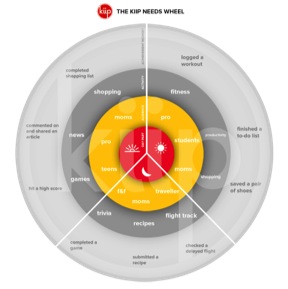The ultimate desire of any brand is to figure out how to be a part of your day without advertising to you. Let me help you get through your day without you expecting it. Let me be there when you don't even know you need me. That's the mark of a very human approach, and it is becoming increasingly accessible for small business marketers to participate.
The idea is simple: across the day, there are various audiences that will be engaged in various activities, which result in moments. Understanding these moments and pairing them with an applicable reward results in what we affectionately call "The Needs Wheel." 
Particularly for small businesses, where every marketing dollar is immensely valuable, the thought of mobile marketing often draws fear akin to mass mailers. They see it as the equivalent of blanketing irrelevant and expensive areas, which only introduce the brand during activities where they really should't be participating. Understanding these mobile moments and needs is crucial as activities are becoming increasingly plentiful, but producing moments with relevance becomes truly magical. Think not just being there on a recipe app as a banner ad, but right there after someone bookmarks a recipe with an actionable reward that acknowledges that they just did something significant.
When we first launched Kiip, the top behavior we identified across the entire day was gaming. Mobile games are continuously dominating every demographic across every hour of every day - but we also realized that on top of gaming other behaviors were gaining steam as well. We began to start with highly sought after demographics with certain traits that were attractive to brands, but naturally difficult to engage with in a genuine way.
We identified three categories where we were able to identify "moments" - health, cooking and productivity:
•In health: think the workout moment, the morning moment, the POS (point-of-sweat) moment, the social workout moment.
•In recipe/food: think the cooking moment, the discovery moment, the personal validation moment.
•In productivity: the to-do list moment, the procrastination moment, the earlybird moment, the late evening doer moment.
For example, in the time you've been reading this first part of my post, 9,827 people have completed a run, 18,741 people have completed a to-do list, 8,287 people have hit a high score in a puzzle game, and 85 moms have bookmarked a recipe in the state of New York.
To wrap it all up: we're owning lifestyle moments. We realize that to disrupt this space, there needs to be both scale and intense relevancy. I remember when I first met Michael Roth (CEO, Interpublic), he told me, "...the moment encompasses two of the most important things marketers looks for: audience and relevancy."
The challenge was how we could take these moments and do something meaningful in them. It's really easy to shove an ad in there but you're now taking what was an opportunity to impress and doing what was expected. Do something unexpected and be the gentleman to your audience.
The goal here is to help consumers realize that the "ad" does need to be a necessary evil. That when we pay $0.99 to remove ads we're paying to remove an entire industry. That doesn't need to be the case. Small businesses are beginning to show someone just how helpful an "ad" can really be.